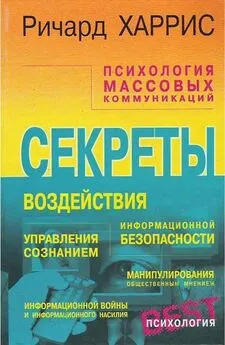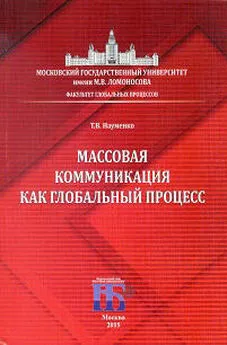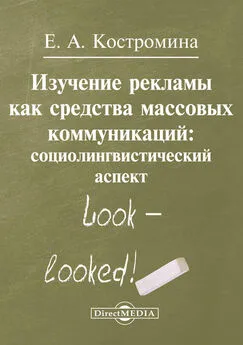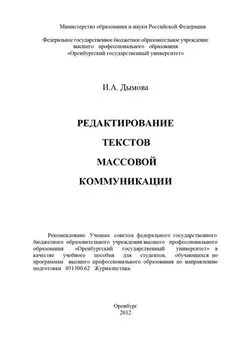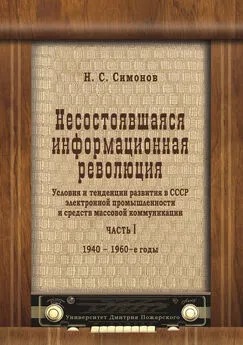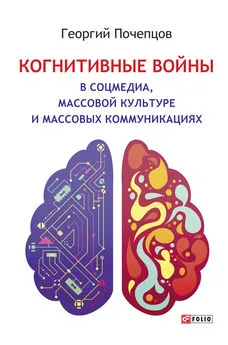Ричард Харрис - Психология массовых коммуникаций
- Название:Психология массовых коммуникаций
- Автор:
- Жанр:
- Издательство:2002
- Год:2002
- Город:Санкт-Петербург
- ISBN:5-93878-033-0
- Рейтинг:
- Избранное:Добавить в избранное
-
Отзывы:
-
Ваша оценка:
Ричард Харрис - Психология массовых коммуникаций краткое содержание
«Предупреждён – значит вооружён». Такой эпиграф мог бы открывать эту книгу. И не имеет значения, кто возьмёт её в руки. Специалист почерпнёт в ней новые приёмы и подходы к анализу стратегии и тактики СМИ. Любознательный обыватель научится обеспечивать собственную информационную безопасность.
Кроме того картина информационного ландшафта современного общества от предвыборного управления массовым сознанием до рекламы памперсов оказывается настолько захватывающей, что однажды начав читать эту книгу, вы уже не оставите её недочитанной.
Психология массовых коммуникаций - читать онлайн бесплатно полную версию (весь текст целиком)
Интервал:
Закладка:
Hass, R. G. (1981). Effects of source characteristics on cognitive responses and persuasion. In: R. E. Petty, T. M. Ostrom, T C. Brock (Eds.). Cognitive responses in persuasion (p. 141–172). Hillsdale, NJ: Lawrence Eribaum Associates.
Hatfield. E., Cacioppo, J. T. Rapson, R. L. (1992). Primitive emotional contagion. In: M. S. Clark (Ed.). Review of personality and soda/psychology: Vol. 14. Emotions and social behavior. Newbury Park , CA : Sage.
Hawkins, R. P.. Kirn, Y.-H., Pingree, S. (1991). The ups and downs of attention to television. Communication Research, 18, 53–76.
Hawkins, R. P., Pingree, S. (1990). Divergent psychological processes in constructing social reality from mass media content. In: N. Signorielli M. Morgan (Eds.). Cultivation analysis (p. 35–50). Newbury Park , CA : Sage.
Hayes, D., Birnbaum, D. W. (1980). Preschoolers' retention of televised events: Is a picture worth a thousand words? Developmental Psychology, 16, 410–416.
Healy, J. (1990). Endangered minds: Why our children's don't think. New York : Simon Schuster.
Hearold, S. (1986). A synthesis of 1043 effects 6f television on social behavior. In: G. Comstock (Ed.). Public communication and behavior (Vol. I, p. 65–133). Orlando , FL : Academic Press.
Heath, R. L., Bryanl, J. (1992). Human communication theory and research: Concepts, contexts, and challenges. Hillsdalc , NJ : Lawrence Eribaum Associates.
Heath, Т . В ., Mothersbaugh, D. L., McCarthy, M. S. (1993). Spokesperson effects in high involvement markets. Advances in Consumer Research, 20, 704–707.
Hebditch, D., Anning, N. (1988). Porn gold: Inside the pornography business. London : Faber Faber.
Heritage, J. (1985). Analyzing news interviews: Aspects of the production of talk for an overhearing audience. In: T. A. van Dijk (Ed.). Handbook of discourse analysis (Vol. 3. p. 95–117). London : Academic Press.
Herman, E. S., Chomsky. N. (1988). Manufacturing consent: The political economy of the mass media. New York : Pantheon.
Herman, E. S., O'Sullivan, G. (1989). The terrorism industry: The experts and institutions that shape our view of terror. New York: Pantheon.
Hinck, E. A. (1992). Enacting the Presidency: Political argument. Presidential debates, and Presidential character. Westport, CT: Praeger.
Hirschberg, M. S. (1993). Perpetuating patriotic perceptions: The cognitive function of the Cold War. Westport, CT: Greenwood.
Hoover, S. M. (1988). Mass media religion. Newbury Park, CA: Sage.
Hoover, S. M., Lundby, K. (Eds.) (I 997). Rethinking media, religion, and culture. Thousand Oaks, CA: Sage.
Hopkins, R., Fletcher, J. E. (1994). Electrodermal measurement: Particularly effective for forecasting message influence on sales appeal. In: A. Lang (Ed.). Measuring psychological responses tomedia (p. 113–132). Hillsdale. NJ: Lawrence Eribaum Associates.
Howitt, D. (1982). Mass media and social problems. Oxford, England: Pergamon Press.
Huesmann, L. R., Eron, L. D. (1986). Television and the aggressive child. Hillsdale, NJ: Lawrence Eribaum Associates.
Huston, A. C., Wright. J. C. (1987). The forms of television and the child viewer. In: G. A. Comstock (Ed.). Public communication and behavior (Vol. 2, p. 103–159). New York: Academic Press.
Jiyama, Р ., Kitano, H. H. L. (1982). Asian-Americans and the media. In: G. L. Berry C. Mitchell-Kernan (Eds.). Television and the socialization of the minority child (p. 151–186). New York: Academic Press, Ilola, L. M. (1990). Culture and health. In: R. W. Brislin (Ed.). Applied cross-cultural psychology (p. 278–301). Newbury Park, CA: Sage.
Intons-Peterson, M. J., Roskos-Ewoldsen, B. (1989). Mitigating the effects of violent pornography. In: S. Gubar J. Hoff-Wilson (Eds.). For adult users, only. Bloomington: Indiana University Press.
Jackson, D. Z. (1989, January 22). Calling the plays in black and white. The Boston Globe, p. A30–A33.
Jacoby, J., Hoyer, W. D. (1987). The comprehension and miscomprehension of print communication: A study of mass media magazines. Hillsdale, NJ: Lawrence Eribaum Associates.
Jamieson, K. H. (1992). Packaging the Presidency: A history and criticism of Presidential campaign advertising (2nd ed.) New York: Oxford University Press.
Jamieson, K. H., Campbell, К . К . (1992). The interplay of influence: News, advertising, politics, and the mass media (3rd ed.). Belmont, CA: Wadsworth.
Janis, I. L. (1980). The influence of television on personal decision making. In: S. B. Withey R. P. Abeles (Eds.). Television and social behavior (p. 161–189). Hillsdale, NJ: Lawrence Eribaum Associates.
Jhally, S., Lewis, J. (1992). Enlightened racism: The Cosby Show, audiences, and the myth of the American dream. Boulder, CO: Westview Press.
Johnson, D., Rimal, R. N. (1994, July). Analysis of HIV/AIDS television public service announcements around the world. Paper presented at International Communication Association meeting, Sydney, Australia.
Johnson-Cartee. K. S., Copeland. G. A. (1991). Negative political advertising: Coming of age. Hillsdalc, NJ: Lawrence Eribaum Associates.
Johnson-Cartee, K. S., Copeland, G. A. (1997). Manipulation of the American voter. Political campaign commercials. New York: Praeger.
Johnston, J., Ettema. J. (1982). Positive images: Breaking stereotypes with children's television. Beverly Hills, CA: Sage.
Johnston, J., Ettema, J. S. (1986). Using television to best advantage: Research for prosocial television. In: J. Bryant D. Zillmann (Eds.). Perspectives on media effects (p. 143–164). Hillsdale, NJ: Lawrence Eribaum Associates.
Jowett. G. S. (1993). Toward a propaganda analysis of the Gulf War. In: B. S. Greenberg W. Gantz (Eds.). Desert Storm and the mass media (p. 76–98). Cresskill, NJ: Hampton Press.
Jowett, G. S., Linton, J. M. (1989). Movies as mass communication (2nd ed.). Newbury Park, CA: Sage.
Joy, L. A., Kimball, M. M., Zabrack, M. L. (1986). Television and children's aggressive behavior. In: Т . М . Williams (Ed.). The impact of television: A natural experiment in three communities (p. 303–360). Orlando, FL: Academic Press.
Kaid, L. L., Gerstle, J., Sanders, K. R. (Eds.). (1991). Mediated politics in two cultures: Presidential campaigning in the United Stales and France. New York: Prager.
Kaid, L. L., Holtz-Bacha, C. (Eds.). (1995). Political advertising in Western democracies: Parties and candidates on television. Thousand Oaks, CA: Sage.
Kardes, F. R. (1992). Consumer inference: Determinants, consequences, and implications for advertising. In: A. A. Mitchell (Ed.). Advertising exposure, memory, and choice. Hillsdale, NJ: Lawrence Eribaum Associates.
Kelly, H. (1981). Reasoning about realities: Children's evaluations of television and books. In: H. Kelly H. Gardner (Eds.). Viewing children through television. San Francisco: Jossey-Bass.
Kern-Foxworth, M. (I994). Aunt Jemima, Uncle Ben, and Rastus: Blacks in advertising, yesterday, today, and tomorrow. Westport, CT: Praeger.
Key, W. B. (1989). The age of manipulation. New York: Holt.
Kiesler, S. (Ed.). (1997). Culture of the Internet. Mah-wah. NJ: Lawrence Eribaum Associates.
Kimball, M. M. (1986). Television and sex-role attitudes. In: T. M. Williams (Ed.). Theim-pact of television: A natural experiment in three communities (p. 265–302). Orlando, FL: Academic Press.
Kintsch, W. (1977). On comprehending stories. In: P. Carpenter M. Just (Eds.). Cognitive processes in comprehension. Hillsdale, NJ: Lawrence Eribaum Associates.
Klatell, D. A., Marcus, N. (1988). Sports for sale: Television, money, and the fans. New York: Oxford University Press.
Knill, B. J., Pesch, M., Pursey, G., Gilpin, P., Perloff, R. M. (1981). Still typecast after all these years? Sex role portrayals in television advertising. International Journal of Women's Studies. 4, 497–506.
Kopkind, A. (1993, May/June). From Russia with love and squalor Utne Reader, p. 80–89.
Kosicki, G. M. (1993). Problems and opportunities in agenda-setting research. Journal of Communication, 43(2). 100–127.
Kottak, C. P. (1990). Prime time society: An anthropological analysis of television and culture. Belmont, CA: Wadsworth.
Krafka, C. L. (1985). Sexually explicit, sexually violent, and violent media: Effects of multiple naturalistic exposures and debriefing on female viewers. Unpublished doctoral dissertation. University of Wisconsin, Madison. Kraus, S. (Ed.). (1962). The great debates. Bloomington, IN: Indiana University Press.
Kraus, S. (Ed.). (1977). The great debates: 1976, Ford vs. Carter. Bloomington, IN: Indiana University Press. Kraus, S. (1988). Televised presidential debates and public policy. Hillsdale, NJ: Lawrence Eribaum Associates.
Kraus, S. (1996). Winners of the first 1960 televised Presidential debate between Kennedy and Nixon. Journal of Communication, 46(4), 78–96.
Kubey, R. (1980). Television and aging: Past, present, and future. Gerontologist, 20, 16–35.
Kubey, R. (1986). Television use in everyday life: Coping with unstructured time. Journal of Communication. 36, 108–123.
Kubey, R. (1992). A critique of No Sense of Place and the homogenization theory of Joshua Meyrowitz. Communication Theory. 2, 259–271.
Kubey. R., Csikszentmihalyi, M. (1990). Television and the quality of life: How viewing shapes everyday experience. Hillsdale, NJ: Lawrence Eribaum Associates.
Kuiper, K. (1995). Smooth talkers: The linguistic performance of auctioneers and sports-casters. Hillsdale, NJ: Lawrence Eribaum Associates.
Kunkel. D. (1988). Children and host-selling television commercials. Communication Research, 15(1), 71–92.
Kunkel, D. (1998). Policy battles over defining children's educational television. The Annals of the American Academy of Political and Social Science, 557, 39–53.
Kutchinsky, B. (1973). The effect of easy availability of pornography on the incidence of sex crimes: The Danish experience. Journal of Social Issues, 29(3), 163–181.
Lambert, W. E., Klineberg, 0. (1967). Children's views of foreign peoples: A cross-national study. New York: Appleton-Century-Crofts.
Lang, A. (1990). Involuntary attention and physiological arousal evoked by structural features and emotional content in TV commercials. Communication Research. 17 275–299.
Lang, A. (1991). Emotion, formal features, and memory for televised political advertisements. In: F. Biocca (Ed.). Television and political advertising: Vol. I. Psychological processes (p. 221–243). Hillsdale, NJ: Lawrence Eribaum Associates.
Lang, A. (Ed.). (1994 a). Measuring psychological responses to media. Hillsdale, NJ: Lawrence Eribaum Associates.
Lang, A. (1994 b). What can the heart tell us about thinking? In A. Lang (Ed.). Measuring psychological responses to media (p. 99–112). Hillsdale NJ: Lawrence Eribaum Associates.
Lang, A., Geiger, S., Strickwerda, M., Sumner, J. (1993). The effects of related and unrelated cuts on television viewers' attention, processing capacity, and memory. Communication Research, 20, 4–29.
Lang, G. E., Lang, K. (1984). Politics and television re-viewed. Beverly Hills, CA: Sage. Lang, K., Lang, G. E. (1968). Politics and television. Chicago: Quadrangle Books.
Lapchick, R., Rodriguez, A. (1990). Professional sports: The 1990 racial report card. Center for the Study of Sport in Society Digest, 2(2), 4–5.
Larsen, S. F. (1983). Text processing and knowledge updating in memory for radio news. Discourse Processes, 6, 21–38.
Larson, J. F. (1984). Television's window on the world: International affairs coverage on the U. S. networks. Norwood, NJ: Ablex.
Larson, J. F. (1986). Television and U. S. foreign policy: The case of the Iran hostage crisis. Journal of Communication. 36(4), 108–130.
Читать дальшеИнтервал:
Закладка:
